The fiercely guarded academic autonomy of these institutions of excellence is anathema to the country’s politicians. Therefore from time to time efforts are made by government to pack their governing boards
THE ONLY HIGHER EDUCATION institutions anywhere near global standards established in post-independence India are the country’s Top 8 (out of 16) Indian Institutes of Technology (IITs) and 13 Indian Institutes of Management (IIMs). Sited on sprawling campuses of hundreds of acres, the Central government-promoted IITs and IIMs are superbly equipped with excellent infrastructure, libraries, laboratories and residential accommodation, and globally famous for the high quality of graduates and postgrads they certify.
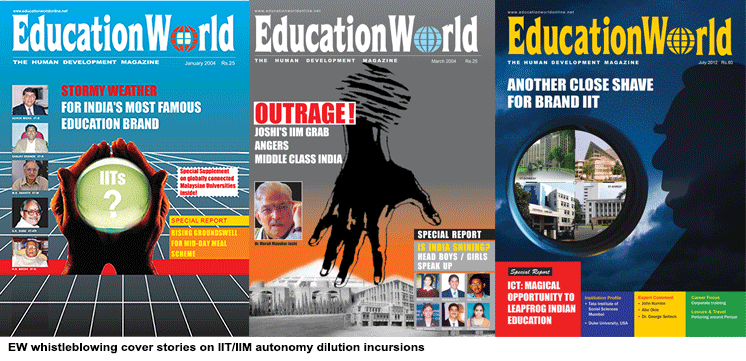 The great reputation of IITs and IIMs is not just the outcome of stiff entrance examinations which enable them to choose the country’s brightest and best higher secondary school-leaving students (IITs) and graduates (IIMs), but also because of the fiercely guarded academic autonomy of these institutions. Naturally, this is anathema to the country’s overweening politicians used to having their way. Therefore from time to time, subtle and not-so-subtle efforts are made by government to control and/or pack the governing boards of these prized institutions.
The great reputation of IITs and IIMs is not just the outcome of stiff entrance examinations which enable them to choose the country’s brightest and best higher secondary school-leaving students (IITs) and graduates (IIMs), but also because of the fiercely guarded academic autonomy of these institutions. Naturally, this is anathema to the country’s overweening politicians used to having their way. Therefore from time to time, subtle and not-so-subtle efforts are made by government to control and/or pack the governing boards of these prized institutions.
The most blatant attempt to grab control of the IITs and IIMs was made by Dr. Murli Manohar Joshi, a former physics professor appointed Union HRD minister of the first BJP-led NDA government, in November 2003. Searching for an excuse to interfere with these inconveniently autonomous institutions, Joshi attempted to ingratiate himself with the middle class by unilaterally slashing the already heavily-subsidised tuition fees to Rs.30,000 per year, to increase their dependence upon ministry grants. Moreover, he decreed that all donations and endowments received by Central government-run education institutions had to be made to a Bharat Shiksha Khoj fund controlled by the HRD ministry, which would allocate them at its discretion. Naturally, some HRD bureaucrats had to be inducted into the governing boards of the institutes to ensure compliance.
EducationWorld which unambiguously condemned this backdoor takeover conspiracy in two detailed cover stories described Joshi as the “proverbial bull in a china shop who could wreck Indian education” (EW January & March 2004). Fortunately a few months later, Joshi was banished into political wilderness following the unexpected defeat of the BJP-NDA coalition in General Election 2004.
Curiously, Joshi’s abortive IITs and IIMs smash-and-grab attempt which ended in disgrace, didn’t deter Kapil Sibal, another bull-in-china shop Union HRD minister from attempting to fix the IITs which didn’t need fixing. Eight years later in May 2012, “in a burst of nationalist passion”, decreeing “one nation one test”, Sibal abolished the traditional IIT-JEE conducted by the IITs, and introduced a common entrance exam for all Central government-run engineering colleges (including the IITs).
The minister’s insistence that the new exam format be introduced with immediate effect without allowing time for careful examination of its full implications, prompted the faculties and alumni of several IITs to raise the banner of revolt. In particular, there was grave concern given that quality of curriculums prescribed by the country’s numerous examination boards is uneven, and that some boards are more generous in awarding marks than others, the proposal to give 40 percent weightage to class XII exam results was ill-advised.
Inevitably, your editors were more sympathetic to the viewpoint expressed by the IITs and welcomed their taking “a stand against reckless implementation of a policy directive which could have diluted brand IIT” (cover story July, 2012). In the end, a compromise was reached with the class XII marksheets given weightage for qualifying to write the IIT-Mains but the IIT-Advanced for admission into IITs is conducted solely by the institutes. Once again it was a near thing.
National Knowledge Commission damp squib
To its credit NKC quickly drew an intelligent roadmap for reforming and re-energising India’s school, higher and vocational education systems. But...
ONE OF THE MOST PROMISING INITIATIVES of the Congress-led UPA I government which failed to take off because of neglect and indifference, was the National Knowledge Commission (NKC). Established in 2005 to “build excellence in the educational system and meet the knowledge challenges of the 21st century and increase India’s competitive advantage in the fields of knowledge”, the NKC was chaired by Satyen (‘Sam’) Pitroda, the US-based multi-millionaire and charismatic technologist-visionary, widely acknowledged as the leader of India’s telecom revolution which has completely transformed the Indian economy. .gif)
Comprising a stellar board of members including Deepak Nayyar, former Delhi University vice chancellor, well-known sociologist Andre Beteille, Infosys co-founder Nandan Nilekani, and Pratap Bhanu Mehta, president Centre for Policy Research, NKC aroused tremendous enthusiasm within academia and the media including EducationWorld which ran a detailed cover story on the commission which promised to transform “resource-starved contemporary India into a knowledge society” (EW November 2005).
To its credit, the NKC quickly delivered a 68-page Report to the Nation 2006 to the Union government on January 12, 2007. It drew an intelligent roadmap for reforming and re-energising India’s school, higher, and vocational education systems. Among its important recommendations to the UPA-I government: enact a Right to Education Act; increase spending on education to 6 percent of GDP; expand higher education by establishing 1,500 universities nationwide to enable India to attain a gross enrolment ratio of at least 15 percent by 2015; disband the multiplicity of higher education regulatory agencies (UGC, AICTE) whose “mandates are confusing and overlapping”, and establish an Independent Regulatory Authority for Higher Education. Other recommendations: nurture 50 globally comparable National Universities of academic excellence and abolish the system of affiliating undergraduate colleges to universities.
Although the UPA-I government accepted the NKC’s recommendations in principle, they didn’t gain traction because of the then socialist HRD minister Arjun Singh’s ideological predilections, and his focus on pushing through a constitutional amendment to reserve quotas for votes-rich OBCs (other backward castes) in Central government universities and institutions, including the IITs and IIMs. Even when Singh was consigned to oblivion after the Congress-led UPA was returned to office following the general election of 2009, the NKC recommendations suffered neglect because the newly installed government was quickly engulfed in a series of corruption scandals with only the Right to Free and Compulsory Education (RTE) Act, 2009 legislated.
With lazy and status quo Indian academics also exhibiting little interest in the NKC reform recommendations (according to Pitroda less than 100 academics and vice chancellors offered any feedback to the commission’s recommendations), Pitroda returned to the US, disillusioned and dejected. Now with a BJP government beholden to its isolationist hindutva propagating lunatic fringe in power at the Centre, chances of the revival of NKC’s recommendations have dimmed considerably, if not disappeared altogether.
Successively ineffective HRD ministers
An extraordinary misfortune of Indian education during the past 15 years is that the critically important human resource development portfolio at the Centre has been allocated to purblind, authoritative politicians unable to give focused attention to the development needs of the world’s largest child population
AN EXTRAORDINARY MISFORTUNE of Indian education during the past 15 years is that the critically important human resource development (aka education) portfolio at the Centre has been allocated to purblind, authoritative politicians unwilling and/or unable to give their focused attention to the nurturance and development needs of the world’s largest child and youth population. In 1999, India’s first BJP-led National Democratic Alliance (NDA) coalition government was voted to power in New Delhi. Its choice of Dr. Murli Manohar Joshi as Union HRD minister, seemed to augur well for Indian education.
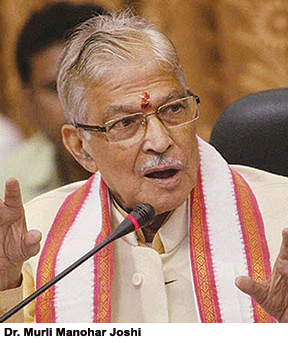 Yet instead of focusing on attaining the MDG (Millennium Development Goal) of universal primary education, Joshi frittered away this opportunity by commissioning the rewriting of school textbooks by ill-qualified hindutva hardliners, and recklessly interfering with the administration and fee structures of the IITs and IIMs (see pg.66).
Yet instead of focusing on attaining the MDG (Millennium Development Goal) of universal primary education, Joshi frittered away this opportunity by commissioning the rewriting of school textbooks by ill-qualified hindutva hardliners, and recklessly interfering with the administration and fee structures of the IITs and IIMs (see pg.66).
Following the surprise defeat of the BJP-NDA coalition in India’s 14th General Election of 2004, and swearing-in of a Congress-led 17 party UPA (United Progressive Alliance) government in New Delhi, the HRD portfolio was allotted to Congress party stalwart Arjun Singh. A die-hard socialist of the Soviet school, Singh was unable to come to terms with the surprise appointment of technocrat-bureaucrat Manmohan Singh as prime minister by Congress party chief Sonia Gandhi, and spent his entire term attempting to upstage his prime minister.
This was most spectacularly demonstrated in 2006 when out of the blue, Arjun Singh unilaterally resurrected the moth-balled Mandal Commission’s Report (1980) to declare an additional reserved quota (i.e in addition to the 22.5 percent quota for scheduled castes and tribes) in all Central government institutions of higher education for OBCs (other backward castes). Given that (according to the Mandal report) OBCs constitute 52 percent of India’s population, all the constituent parties of the UPA — indeed all political parties — were obliged to support this proposal which was expeditiously enacted as the Central Educational Institutions (Reservations in Admission) Act, 2006. 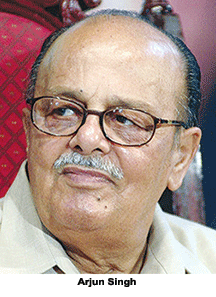
Inevitably, this parliamentary coup, which translated into 49.5 percent capacity in India’s top-ranked Central government universities and institutes — including IITs and IIMs — being reserved for specified educationally backward communities admitted on non-merit considerations, provoked a countrywide caste war and rain of litigation. Finally, a Supreme Court judgement in Ashoka Kumar Thakur vs. Union of India & Ors (Writ Petition (civil) 265 of 2006), unanimously approved the 93rd Amendment to the Constitution of India and the consequential Central Educational Institutions (Reservation in Admission) Act, 2006, restricting the ambit of its verdict to Central government-run institutions of higher education (i.e not opining about its applicability to private professional colleges).
Subsequently in response to public pressure, a political compromise solution was engineered by the UPA-I government under which the capacity of Central government-run colleges and universities was simultaneously expanded by 27 percent to protect the merit quota. But in the process, the resources of these institutions were severely stretched, diluting the quality of education they dispense.
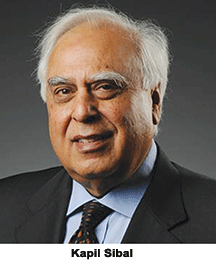 Arjun Singh’s ambition and machinations proved his undoing. When the Congress-led UPA coalition was returned to power in New Delhi after General Election 2009, Singh was not allocated a ministerial portfolio and faded into obscurity. His successor as Union HRD minister was Kapil Sibal, a brilliant Supreme Court lawyer who had given a good account of himself as Union minister for science and technology in the UPA-I government. But after a good beginning, Sibal who emerged as a prime spokesperson of the Congress party as it slipped deep into corruption, lost his focus.
Arjun Singh’s ambition and machinations proved his undoing. When the Congress-led UPA coalition was returned to power in New Delhi after General Election 2009, Singh was not allocated a ministerial portfolio and faded into obscurity. His successor as Union HRD minister was Kapil Sibal, a brilliant Supreme Court lawyer who had given a good account of himself as Union minister for science and technology in the UPA-I government. But after a good beginning, Sibal who emerged as a prime spokesperson of the Congress party as it slipped deep into corruption, lost his focus.
For instance, instead of addressing the root problem of improving teaching-learning standards in the country’s 1.20 million government primary schools, he decreed a 25 percent quota for poor neighbourhood children in private schools under the Right to Free and Compulsory Education (RTE) Act, 2009. More dangerously, exams have been abolished and promotions made automatic in elementary education (classes I-VIII) under the Act, even as nothing has been done to raise secondary and higher secondary school-leaving exam standards. Notwithstanding dumbing down of the school education system, he proposed a common entrance exam for all Central government-funded engineering colleges — including the IITs (see ‘IITs & IIMs Control Attempts’ p.66).
With several of Sibal’s ambitious but ill-drafted Bills — including the Foreign Educational Institutions and National.gif) Commission for Higher Education and Research legislation — opposed by his own party members in standing committees of Parliament, and after the 2G telecom spectrum allocation scam was exposed and telecom minister A. Raja was sacked in 2010, Sibal was allocated Raja’s portfolio, bringing down the curtain on his undistinguished tenure in the HRD ministry. Sibal’s successor in Shastri Bhavan was Dr. M.M. Pallam Raju whose claim to fame was that he had continuously been a Lok Sabha member since 1984. But in the final year of the rudderless UPA regime, Raju spent most of his time travelling abroad and evading the media.
Commission for Higher Education and Research legislation — opposed by his own party members in standing committees of Parliament, and after the 2G telecom spectrum allocation scam was exposed and telecom minister A. Raja was sacked in 2010, Sibal was allocated Raja’s portfolio, bringing down the curtain on his undistinguished tenure in the HRD ministry. Sibal’s successor in Shastri Bhavan was Dr. M.M. Pallam Raju whose claim to fame was that he had continuously been a Lok Sabha member since 1984. But in the final year of the rudderless UPA regime, Raju spent most of his time travelling abroad and evading the media.
Following the ignominious rout of the scandals-beset Congress party and its allies in General Election 2014, triumphant BJP prime minister Narendra Modi’s surprise choice to head the critically-important but ill-starred Union HRD ministry is Smriti Irani, a former television soaps star who “misdeclared” herself as an arts graduate of Delhi University. One of her fiats in office was to appoint Dr. Yellapragada Sudershan Rao, a hindutva champion who believes that mythology may well be history, as chairman of the Indian Council of Historical Research.
Another diktat was for all schools to observe a Sanskrit Week, a directive which aroused widespread antagonism in the southern anti-Hindi language states. Currently, the HRD ministry is writing a New Education Policy in which there will be a strong emphasis on propagating Indian culture and values, to be presented to Parliament in January. The auguries aren’t good.
Interminable reservations debate
While reservations in institutes of higher education serve the cause of equity, forced admission of youth from sub-standard primary-secondaries into colleges and universities has adversely affected teaching-learning standards in them
DURING THE PAST 15 YEARS, the attention and energies of the small minority of bona fide education reformers have been canalised into the seemingly endless debate on the issue of reservation of quotas in institutions of higher education by the country’s self-before-public-service politicians, with their eyes firmly fixed on vote banks.
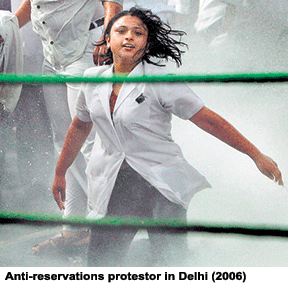 Perhaps the most diligent new millennium champion of reservations for historically oppressed groups was former chief minister of Madhya Pradesh and prime ministerial aspirant Arjun Singh, appointed Union HRD minister in the Congress-led UPA-I government which was unexpectedly voted into power in New Delhi in 2004. In 2005, Singh sprang a surprise upon the government and all political parties by proposing an additional (i.e in addition to the 22.5 percent reserved for SCs and STs) 27 percent reserved quota for OBCs (other backward castes).
Perhaps the most diligent new millennium champion of reservations for historically oppressed groups was former chief minister of Madhya Pradesh and prime ministerial aspirant Arjun Singh, appointed Union HRD minister in the Congress-led UPA-I government which was unexpectedly voted into power in New Delhi in 2004. In 2005, Singh sprang a surprise upon the government and all political parties by proposing an additional (i.e in addition to the 22.5 percent reserved for SCs and STs) 27 percent reserved quota for OBCs (other backward castes).
To get around the inconvenient judgements of the Supreme Court in the T.M.A. Pai Foundation (2002) and P.A Inamdar (2005) cases which freed private education institutions to manage admissions on merit and levy reasonable tuition fees, he pushed a constitutional amendment through Parliament which pointedly overruled these judgements. With OBCs reportedly constituting 52 percent of the population according to the Mandal Commission, the amendment was passed unanimously by Parliament on December 21, 2005. A year later, Parliament passed the Central Educational Institutions (Reservation in Admission) Bill, 2006 on December 14 in the Lok Sabha and four days later in the Rajya Sabha. The Act provided for reservation of 27 percent seats for OBCs in 85 Central government-sponsored higher education institutions.
Inevitably, the constitutional validity of the Act was challenged in the Supreme Court. On April 10, 2008, in Ashoka Kumar Thakur vs. Union of India & Ors (Writ Petition (civil) 265 of 2006), a five-judge bench of the apex court approved the 93rd Amendment to the Constitution and the consequential Central Educational Institutions (Reservation in Admission) Act, 2006.
“With the UPA government having decreed that institutional capacity will have to be increased by 54 percent so that seats available within the general merit category don’t diminish, institutional managements have to quickly recruit additional faculty and plan infrastructure expansion to accommodate the 27 percent additional intake,” commented EducationWorld on the reservations imbroglio (EW May 2006).
With the Supreme Court having sanctioned a ceiling of 49.9 percent reserved quotas in Central government institutions for designated minorities, state governments have been quick to follow with some of them such as Tamil Nadu reserving up to 69 percent capacity in state government colleges and universities for historically underprivileged sections of society. But while reservations in institutes of higher education serve the cause of equity, forced admission of youth from substandard primary-secondary schools into colleges and universities has undoubtedly adversely affected teaching-learning standards in them.
Little wonder that in the annual World University Rankings league tables published by the London-based rating agencies QS and THE, not even one Indian university is ranked among the Top 200, and Indian industry spokespersons routinely express dissatisfaction with the quality of graduates certified by the majority of the country’s 37,000 colleges and 735 universities.
Deep rot in medical education
A rash of scandals in the Medical Council of India which licences and supervises India’s 355 medical colleges, has cast a dark shadow over the medical profession and its commitment to the Hippocratic Oath
IT’S DOUBLE TRAGEDY THAT 21ST century india which has perhaps the world’s most adverse doctor-population ratio — 1:1,700 cf. 1:407 in the US, 1:357 in the UK and 1:714 in China — is also burdened with a rotten medical education system plagued with capacity shortages, corruption, and quality maladies. A rash of scandals in the apex-level Medical Council of India (MCI) which licences and supervises India’s 355 medical colleges has cast a dark shadow over the medical profession, its dubious practices, ethics and commitment to the Hippocratic Oath. In particular, MCI’s reckless licencing of colleges, green-signaling arbitrary capacity enhancement, and approval of substandard postgraduate programmes during the past decade has raised serious doubts about the competence and professional capability of the 41,469 medical graduates (MBBS) certified annually.
The deep ills of medical education were nationally exposed on April 22, 2010 when the CBI (Central Bureau of Investigation) arrested Ketan Desai, chairman of the Medical Council of India, on corruption charges. During his reign (2001-10), Desai allegedly amassed a huge fortune by brazenly auctioning MCI’s licensing, recognition and discretionary powers to ‘recognise’ 35 new medical colleges, most of them with grossly inadequate infrastructure and faculty. .gif)
In deep-detail special reports EducationWorld (August 2012 and May 2014) regretted that “for the past 80 years since independence MCI has through an opaque licencing system severely constrained capacity expansion in medical education, with the council acquiring a notorious reputation for corruption and graft even as successive governments at the Centre and in the states discouraged education entrepreneurs from creating new capacity by decreeing forced fee subsidies and reserved quotas in private medical colleges”.
The explosion of med scams and Desai’s arrest forced the Central government to dissolve MCI in 2010. Subsequent to its disbandment, the Union health ministry constituted a six-member interim Board of Governors with a one-year term, and in November 2013 the UPA-II government reconstituted MCI with 68 (of the total 130) members elected/nominated by various states and universities under the Indian Medical Council (Amendment) Second Ordinance, 2013. However several state universities are yet to propose members for the newly constituted MCI which will have a term of four years.
MCI reconstitution apart, the UPA-II government’s other attempts to reform medical education were: promoting six new AIIMS (All India Institute of Medical Sciences) calibre institutions in Bhopal, Bhubaneswar, Jodhpur, Patna, Raipur and Rishikesh; a National Commission for Human Resources for Health Bill (NCHRH), 2011, and compulsory one-year rural service for MBBS graduates and postgraduates. While the six new AIIMS are in various stages of operationalisation, the NCHRH Bill was rejected by the Parliamentary Standing Committee, and the compulsory rural service order never took off.
With government (Centre plus states) expending a mere 1.4 percent of GDP on public health (cf. 8-10 percent in OECD countries), the number of medical colleges, public hospitals and rural primary health and medical practitioners need to double within the next five years. But given the deep rot within the medical education and public health system, this seems an impossible dream.
Foreign education institutions entry sabotage
Predictably the entry of FEIs is opposed by dog-in-the-manger academics, Left ideologues, and self-styled guardians of Indian culture
YET ANOTHER ENTERPRISE OF GREAT pith and potential debated, discussed, and botched during the past 15 years was the entry of foreign universities and/or higher education institutions into India. Given the poor quality of tertiary education — a few Central government universities and institutes such as the IITs, IIMs, Indian Institute of Science etc with limited capacity excepted — any household which can afford to do so, sends its children abroad for higher postgrad (and increasingly undergrad) education. Of them, a substantial proportion don’t return inflicting continuous ‘brain drain’ damage on the Indian economy. Moreover, the annual bill of Indian students abroad borne by their parents — who often have to make great sacrifices to gift their children an enabling foreign education experience — aggregates a massive $5.9 billion (Rs.27,000 crore). In the circumstances, it makes good sense to invite foreign universities to establish campuses or link up with Indian universities/institutes, and provide their superior study programmes at more affordable prices in India.
 In the early years of the new millennium, several Indian private colleges and universities started offering diploma/degree courses of foreign education institutions on their domestic campuses, successfully running twinning programmes under which half the study programme is completed in India and the other half in partner universities abroad, a development which as early as 2004 EducationWorld reported as “manna from heaven” for a huge number of upwardly mobile students (EW February 2004). Inevitably, the entry of foreign education institutions (FEIs) was opposed by dog-in-the-manger academics, Left ideologues and the country’s ubiquitous guardians of Indian culture as reported in another EW cover feature a year later (March 2005). However, during the first term of the Congress-led UPA-I government (2004-09), the Foreign Educational Institutions (Regulation of Entry and Operations, Maintenance of Quality and Prevention of Commercialisation) Bill, first introduced in the Rajya Sabha in 1995, and later revived in 2007 was vetoed by the communist parties upon whom the UPA-I government was dependent for its parliamentary majority. Subsequently, the Bill was revived when the UPA-II government was returned to power in Delhi after General Election 2009 and actually cleared by the Union cabinet on March 15, 2010.
In the early years of the new millennium, several Indian private colleges and universities started offering diploma/degree courses of foreign education institutions on their domestic campuses, successfully running twinning programmes under which half the study programme is completed in India and the other half in partner universities abroad, a development which as early as 2004 EducationWorld reported as “manna from heaven” for a huge number of upwardly mobile students (EW February 2004). Inevitably, the entry of foreign education institutions (FEIs) was opposed by dog-in-the-manger academics, Left ideologues and the country’s ubiquitous guardians of Indian culture as reported in another EW cover feature a year later (March 2005). However, during the first term of the Congress-led UPA-I government (2004-09), the Foreign Educational Institutions (Regulation of Entry and Operations, Maintenance of Quality and Prevention of Commercialisation) Bill, first introduced in the Rajya Sabha in 1995, and later revived in 2007 was vetoed by the communist parties upon whom the UPA-I government was dependent for its parliamentary majority. Subsequently, the Bill was revived when the UPA-II government was returned to power in Delhi after General Election 2009 and actually cleared by the Union cabinet on March 15, 2010.
However, the Bill was so loosely drafted it had to be scrutinised and debated in the standing committee for a prolonged period, with some of its provisions resisted by Congress party members. In September 2013, a last-ditch effort was made by then Union HRD minister Dr. Pallam Raju to resurrect the FEI Bill by enacting a Central government ordinance issued under the University Grants Commission (UGC) Act, 1956. But as reported in yet another cover feature (EW October 2013), the conditions imposed upon foreign education institutions aspiring to enter the Indian education marketplace were so restrictive and onerous, there were few takers. Now with the BJP-led NDA government in Delhi held captive by its hindutva revivalist culture vultures, the prospect of FEIs setting up shop in India has become more remote.
Belated awareness of vocational education
The silver lining to the continuous neglect of vocational education and training is the belated promotion of the National Skill Development Corporation in 2009, and a growing number of entrepreneurs contributing to the VET revolution
A CURIOUS ANOMALY OF THE centrally planned indian economy is the inexplicable neglect of vocational education and training (VET). It’s impossible to believe the country’s omniscient wiseacres who presided over the once reportedly 28,000-strong Planning Commission were unaware of the great emphasis that not only the industrially advanced OECD, but even the newly emerging industrial countries such as South Korea and Japan, accorded to VET. Yet in post-independence India, the sin of sustained neglect of early childhood, primary and secondary education has been compounded by continuous neglect of vocational and skills education.
According to i Watch (estb. 1992), a Mumbai-based NGO focused upon the areas of governance, education, economy and employment, currently 90 million youth are enrolled in 500,000 VET institutions across China, and 11 percent of its total labour (816 million) force has received formal VET. On the other hand in India, the number of youth enroled in its 11,800 VET institutions (including 5,114 Industrial Training Institutes run by the Union ministry of labour) is a mere 3.5 million, and only 8-10 percent of ‘organised sector’ workers (30 million) have received formal VET. .gif)
The price the Indian economy has paid for the neglect of VET has been heavy. According to a detailed 2007 study of the Brookings Institution, USA — the world’s top-ranked think tank — during the period 1978-2004, output per worker and total factor productivity in the economy increased by 7.3 percent and 3.8 percent respectively in China cf. 3.3 and 1.6 percent in India. Unsurprisingly India’s wheat production averages 2,688 kg per hectare (kg/ha) compared with 4,155 kg/ha in China.
The silver lining of this grim story is that following loud protests within the intelligentsia and media, the Congress-led UPA-II government in New Delhi belatedly promoted the National Skill Development Corporation (NSDC), a government-industry partnership in 2009. Its mission is to build a sustainable ecosystem to promote skills development through provision of long-term loans to private sector VET firms, set up sector skill councils with employer engagement to prescribe standards and benchmarks, accredit training institutions to certify trainees, and encourage industry to employ trained personnel.
NSDC’s mandate is to ensure that private sector VET providers skill 150 million youth and workers by the year 2020. Since then, NSDC claims to have funded and approved 129 VET institutions which will skill over 78 million individuals by 2015, and attain the 150 million youth target on schedule.
However, an equally promising development is that independently of government, a small minority of NGOs are seriously addressing the critical issue of skills-based education. In a detailed cover story (April 2014) EducationWorld profiled four enterprises promoted by extraordinary social entrepreneurs, who we believe will serve as exemplars to thousands of industry managers and professionals capable of contributing to the quiet skills education revolution gathering momentum countrywide. Better late than never.
Discovery of early childhood education
The socially beneficial outcome of consistent advocacy of ECCE is that on September 20 last year, the Central government approved a National Early Childhood Care and Education Policy
WHILE THE COUNTRY’S EDUCATED MIDDLE class became aware of the importance of early childhood care and education (ECCE) several decades ago, and send their offspring to the country’s estimated 300,000 private pre-primaries which host 10 million relatively privileged tiny tots, the critical importance of ECCE dawned only in the new millennium after neuroscience studies conducted in the US in the noughties conclusively established that children’s brains are almost 90 percent developed by the time they attain the age of eight. A big boost was given to professionally administered ECCE by Dr. James Heckman, awarded the Nobel prize for economics in 2000. In a study paper titled Policies to Foster Human Capital (2000), Dr. Heckman presented a wealth of data to illustrate that the returns are higher for every dollar invested in early childhood education, than on dollars invested later in the education continuum.
.gif) In India, ECCE awareness was impacted upon the mandarins of the HRD ministry not only by the small minority of educators and edupreneurs who braving opprobrium, promoted preschools several decades ago, but also by the Mumbai-based Early Childhood Association (ECA, estb. 2010) and not least by EducationWorld, which has convened four global ECCE conferences during the past four years with the next one scheduled on January 23, 2015 in Mumbai. Indeed, the importance your editors accord to ECCE may be gauged by the fact that EducationWorld has also conducted four annual surveys to rate and rank the country’s best pre-primaries followed by the ECCE global conferences addressed by some of the most respected scholars and practitioners of early childhood education.
In India, ECCE awareness was impacted upon the mandarins of the HRD ministry not only by the small minority of educators and edupreneurs who braving opprobrium, promoted preschools several decades ago, but also by the Mumbai-based Early Childhood Association (ECA, estb. 2010) and not least by EducationWorld, which has convened four global ECCE conferences during the past four years with the next one scheduled on January 23, 2015 in Mumbai. Indeed, the importance your editors accord to ECCE may be gauged by the fact that EducationWorld has also conducted four annual surveys to rate and rank the country’s best pre-primaries followed by the ECCE global conferences addressed by some of the most respected scholars and practitioners of early childhood education.
The socially beneficial outcome of consistent advocacy of ECCE is that on September 20 last year, the Union cabinet of the Congress-led UPA-II government approved a National Early Childhood Care and Education (NECCE) policy drafted by the ministry of women and child development (WCD). NECCE recommends transformation of all 1.6 million anganwadis — funded by the Central government under its Integrated Child Development Services (ICDS) programme started in 1975 — into ECCE centres, and prescribes infrastructure, quality and other benchmarks for the country’s private preschools. But with the UPA II coalition roundly trounced in General Election 2014, the NECCE policy draft has vanished from the radar of the new BJP-led NDA coalition which rules in New Delhi.
“Quite clearly, the national interest demands that the NECCE policy draft is resurrected, processed and amplified because, of the country’s 158 million children aged below six, only 75.7 million i.e. 48 percent are covered under the ICDS’ anganwadi programme, which under the WCD policy draft will also provide early childhood education. Given that only 10 million 0-6 age group children are provided ECCE by the country’s estimated 300,000 private preschools and NGOs, the vast majority of India’s infants are denied professionally administered early childhood education,” commented EducationWorld in our comprehensive cover story titled ‘Education routemap for Modi Express’ (EW August 2014).
EW school rankings enthusiasm
Over the past seven years the annual EducationWorld India School Rankings have transformed into arguably the world’s largest celebration of excellence in primary-secondary education
A LANDMARK DEVELOPMENT IN INDIAN k-12 education was the introduction in 2007 of the annual EducationWorld India School Rankings, and the EducationWorld India Preschool Rankings in 2010. Since then, the EW India School Rankings together with the following EW India School Rankings Awards have transformed into arguably the world’s largest celebration of excellence in primary-secondary education, arousing huge interest and enthusiasm within the teacher, parents and student communities.
Likewise the annual EW India Preschool Rankings survey followed by the EW ECCE Global Conference have been enthusiastically welcomed by young parents, teachers and educators countrywide, prompting the National Early Childhood Care and Education policy draft, approved by the Union government in September 2013 (see p.78). Introduced with the objective of providing parents expert evaluation of primary-secondary schools and pre-primaries across over a dozen parameters of education excellence, these annual surveys and rankings have also had the salutary effect of instilling positive sentiments of institutional pride within K-12 schools across the country. 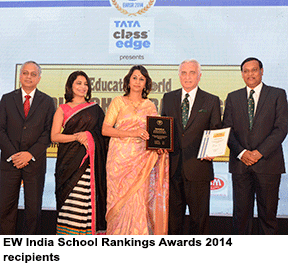
Over the past six years since the first league tables rating and ranking schools countrywide were published, the sample size of respondents and the number of field research personnel conducting the surveys have increased considerably, and survey methodologies and classifications have been consistently improved in response to informed public opinion. Therefore the latest EW India School Rankings 2014 rate and rank schools under ten discrete categories — day co-ed, day-cum-boarding, all-girls and boys day schools; co-ed, girls and all-boys boarding schools; and day, day-cum-boarding and wholly residential international schools — with the league tables also for the first time featuring the average class XII exam scores of CBSE (Central Board of Secondary Education) and CISCE (Council for the Indian School Certificate Examinations)-affiliated schools.
Moreover, to make the rankings more inclusive, a Top 10 ranking of government day and boarding schools was also introduced.
“Undoubtedly, a lot of hard work has gone into publishing the EW India School Rankings 2014 and highlighting the best of the best schools of the country. Many congratulations,” says Dr. Shayama Chona, well-known Delhi-based educationist, in one of the hundreds of congratulatory letters received by the EW office following the publication of our latest rankings. “The concerted effort made by your team is praiseworthy. EducationWorld’s comprehensive school rankings not only provide parents information about institutions but also stimulate schools to improve themselves,” writes Jyoti Gupta, principal, DPS Ghaziabad, in another appreciative email received.
EW lib-lab-lav schema
An EW study indicates that the expense of equipping every government school with a library, laboratory and lavatories would be a mere Rs.47,725 crore — 0.43 percent of current GDP
IN A DEPARTURE FROM CONVENTIONAL journalism which reports the news, and grand plans and projects developed by politicians, the intelligentsia and academics, from time to time the editors of this publication have also presented plans and projects to resolve seemingly intractable problems bedevilling Indian education. EducationWorld commissioned Dr. A.S. Seetharamu, former 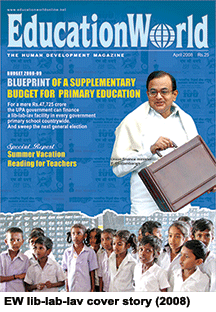 professor of education at the Institute of Social and Economic Change, Bangalore to estimate the cost of equipping every government primary school countrywide with a library, laboratory and lavatories, including separate toilets for girl children. Dr. Seetharamu concluded that the expenditure required would be Rs.47,725 crore, a mere 1.6 percent of GDP in 2008-09. At that time, we advised the Congress-led UPA-I government to incur this expenditure through a firesale of loss-making public sector companies, whose total assets are valued at over Rs.1000,000 crore (EW April 2008).
professor of education at the Institute of Social and Economic Change, Bangalore to estimate the cost of equipping every government primary school countrywide with a library, laboratory and lavatories, including separate toilets for girl children. Dr. Seetharamu concluded that the expenditure required would be Rs.47,725 crore, a mere 1.6 percent of GDP in 2008-09. At that time, we advised the Congress-led UPA-I government to incur this expenditure through a firesale of loss-making public sector companies, whose total assets are valued at over Rs.1000,000 crore (EW April 2008).
Your editors believe that instead of quota reservations in higher education institutions, the interests of the scheduled castes, scheduled tribes, other backward castes and socio-economically underprivileged sections of society will be best served by improving infrastructure and learning outcomes of the country’s 1.20 million government and estimated 300,000 ‘unrecognised’ private budget schools, which would enable their students to compete for admission into top-ranked institutions of higher education. The only response this eminently workable and logical schema has received is perhaps from prime minister Narendra Modi who has stridently proposed provision of lavatories and separate toilets for girl children in all government schools by the year 2017, and the adoption of this proposal in toto by the Children First Party of India promoted by your editors and awaiting favourable tide and winds (www.childrenfirst.in).